University Design Thinking Reflective Paper, MGMT20140 Module
VerifiedAdded on 2023/01/11
|12
|2896
|20
Report
AI Summary
This reflective paper examines the design thinking process, including its stages of defining a problem, ideating solutions, prototyping, and testing. The paper presents a literature review on design thinking's importance in organizational culture and its evolution. It details weekly classroom learnings, such as problem-solving approaches, double-loop learning, poster creation, journey mapping, SWOT analysis, research methodologies, and prototyping techniques. The student identifies strengths, weaknesses, opportunities, and threats, culminating in a personal development plan with specific action items for skill and behavior improvement over the next six months. The paper cross-references the student's blog entries throughout the term, demonstrating engagement with the course material. The paper reflects on the student's growth and understanding of design thinking principles, emphasizing skills in problem identification, teamwork, visualization, and data extraction.
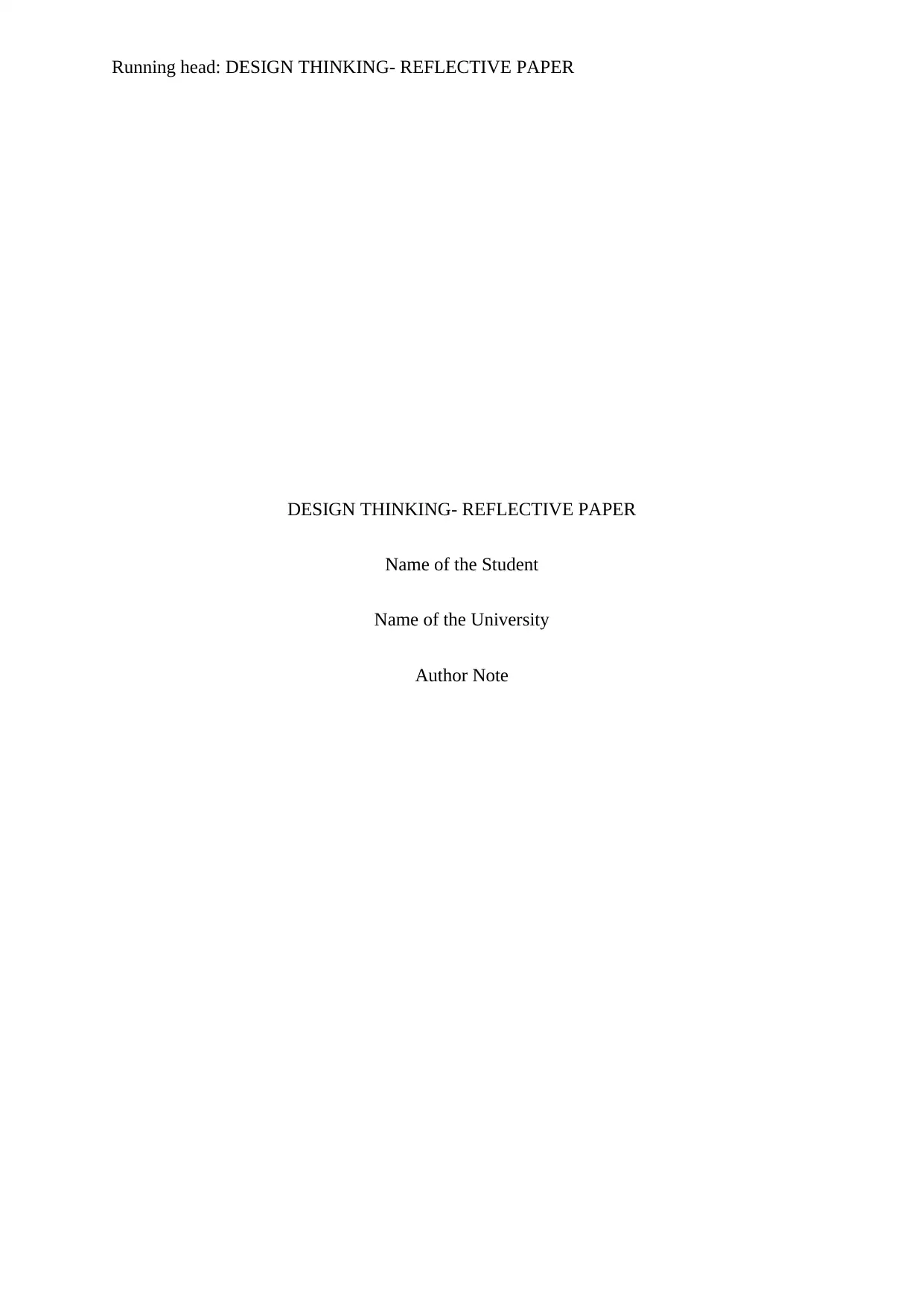
Running head: DESIGN THINKING- REFLECTIVE PAPER
DESIGN THINKING- REFLECTIVE PAPER
Name of the Student
Name of the University
Author Note
DESIGN THINKING- REFLECTIVE PAPER
Name of the Student
Name of the University
Author Note
Paraphrase This Document
Need a fresh take? Get an instant paraphrase of this document with our AI Paraphraser
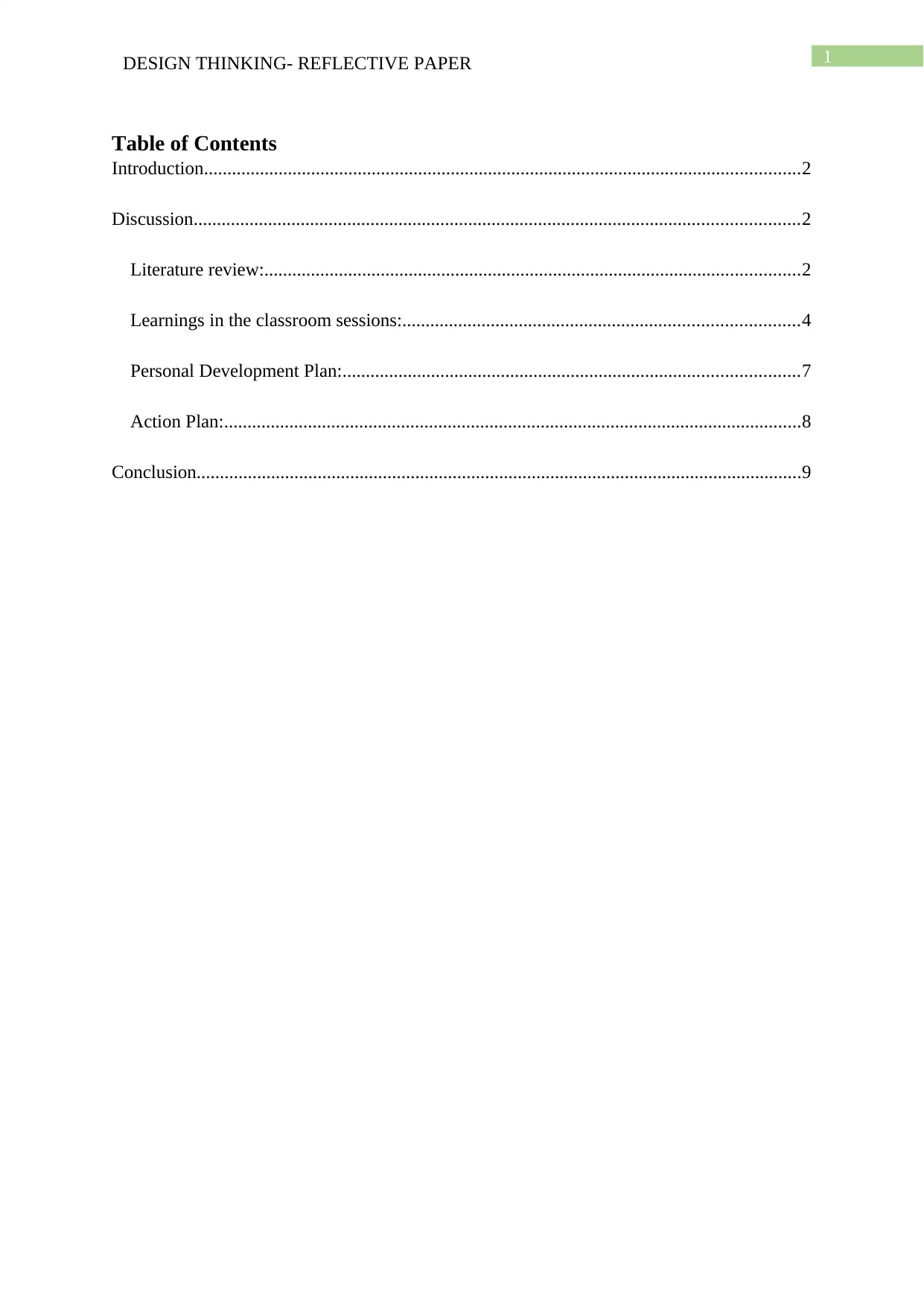
1DESIGN THINKING- REFLECTIVE PAPER
Table of Contents
Introduction................................................................................................................................2
Discussion..................................................................................................................................2
Literature review:...................................................................................................................2
Learnings in the classroom sessions:.....................................................................................4
Personal Development Plan:..................................................................................................7
Action Plan:............................................................................................................................8
Conclusion..................................................................................................................................9
Table of Contents
Introduction................................................................................................................................2
Discussion..................................................................................................................................2
Literature review:...................................................................................................................2
Learnings in the classroom sessions:.....................................................................................4
Personal Development Plan:..................................................................................................7
Action Plan:............................................................................................................................8
Conclusion..................................................................................................................................9
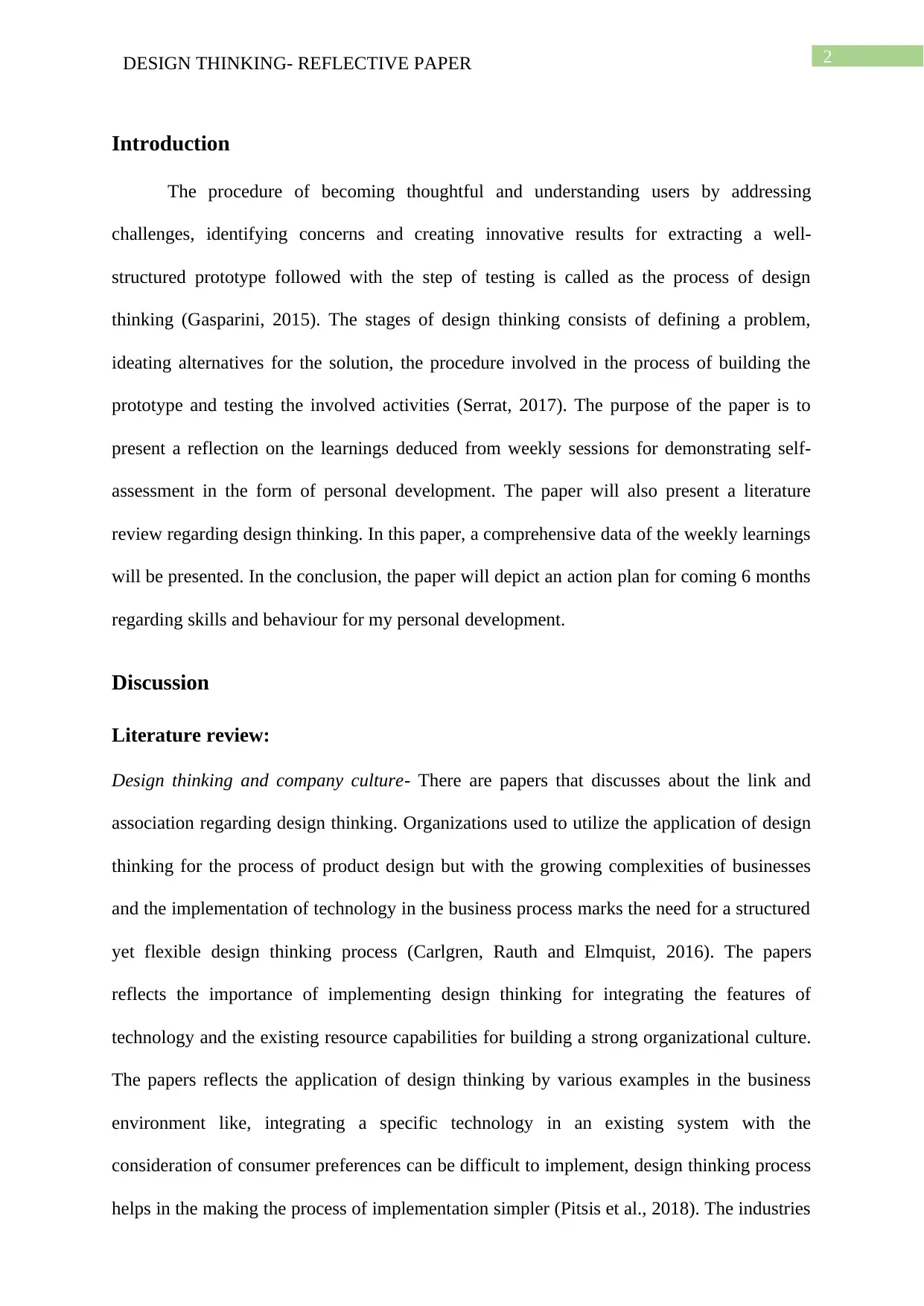
2DESIGN THINKING- REFLECTIVE PAPER
Introduction
The procedure of becoming thoughtful and understanding users by addressing
challenges, identifying concerns and creating innovative results for extracting a well-
structured prototype followed with the step of testing is called as the process of design
thinking (Gasparini, 2015). The stages of design thinking consists of defining a problem,
ideating alternatives for the solution, the procedure involved in the process of building the
prototype and testing the involved activities (Serrat, 2017). The purpose of the paper is to
present a reflection on the learnings deduced from weekly sessions for demonstrating self-
assessment in the form of personal development. The paper will also present a literature
review regarding design thinking. In this paper, a comprehensive data of the weekly learnings
will be presented. In the conclusion, the paper will depict an action plan for coming 6 months
regarding skills and behaviour for my personal development.
Discussion
Literature review:
Design thinking and company culture- There are papers that discusses about the link and
association regarding design thinking. Organizations used to utilize the application of design
thinking for the process of product design but with the growing complexities of businesses
and the implementation of technology in the business process marks the need for a structured
yet flexible design thinking process (Carlgren, Rauth and Elmquist, 2016). The papers
reflects the importance of implementing design thinking for integrating the features of
technology and the existing resource capabilities for building a strong organizational culture.
The papers reflects the application of design thinking by various examples in the business
environment like, integrating a specific technology in an existing system with the
consideration of consumer preferences can be difficult to implement, design thinking process
helps in the making the process of implementation simpler (Pitsis et al., 2018). The industries
Introduction
The procedure of becoming thoughtful and understanding users by addressing
challenges, identifying concerns and creating innovative results for extracting a well-
structured prototype followed with the step of testing is called as the process of design
thinking (Gasparini, 2015). The stages of design thinking consists of defining a problem,
ideating alternatives for the solution, the procedure involved in the process of building the
prototype and testing the involved activities (Serrat, 2017). The purpose of the paper is to
present a reflection on the learnings deduced from weekly sessions for demonstrating self-
assessment in the form of personal development. The paper will also present a literature
review regarding design thinking. In this paper, a comprehensive data of the weekly learnings
will be presented. In the conclusion, the paper will depict an action plan for coming 6 months
regarding skills and behaviour for my personal development.
Discussion
Literature review:
Design thinking and company culture- There are papers that discusses about the link and
association regarding design thinking. Organizations used to utilize the application of design
thinking for the process of product design but with the growing complexities of businesses
and the implementation of technology in the business process marks the need for a structured
yet flexible design thinking process (Carlgren, Rauth and Elmquist, 2016). The papers
reflects the importance of implementing design thinking for integrating the features of
technology and the existing resource capabilities for building a strong organizational culture.
The papers reflects the application of design thinking by various examples in the business
environment like, integrating a specific technology in an existing system with the
consideration of consumer preferences can be difficult to implement, design thinking process
helps in the making the process of implementation simpler (Pitsis et al., 2018). The industries
⊘ This is a preview!⊘
Do you want full access?
Subscribe today to unlock all pages.

Trusted by 1+ million students worldwide
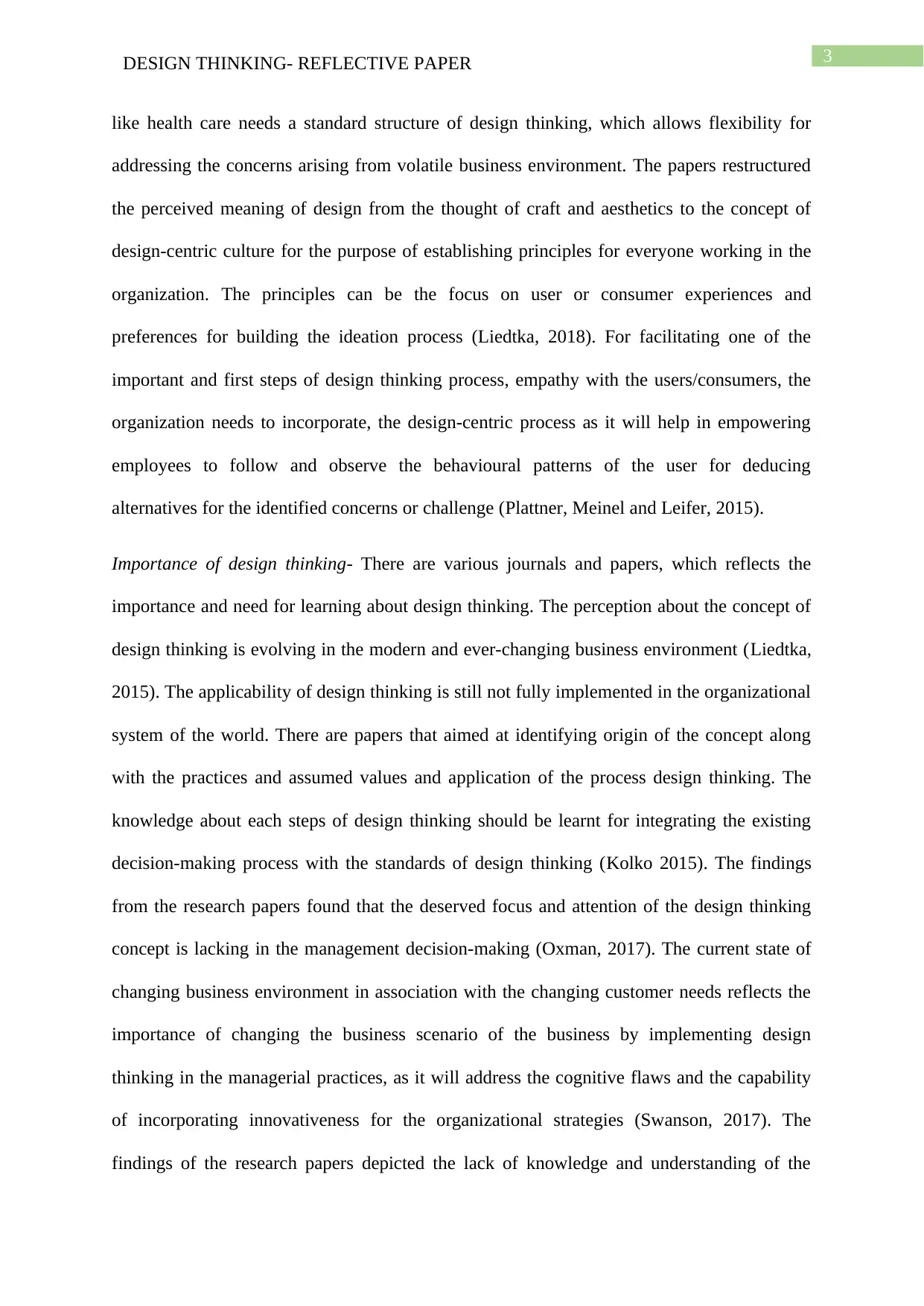
3DESIGN THINKING- REFLECTIVE PAPER
like health care needs a standard structure of design thinking, which allows flexibility for
addressing the concerns arising from volatile business environment. The papers restructured
the perceived meaning of design from the thought of craft and aesthetics to the concept of
design-centric culture for the purpose of establishing principles for everyone working in the
organization. The principles can be the focus on user or consumer experiences and
preferences for building the ideation process (Liedtka, 2018). For facilitating one of the
important and first steps of design thinking process, empathy with the users/consumers, the
organization needs to incorporate, the design-centric process as it will help in empowering
employees to follow and observe the behavioural patterns of the user for deducing
alternatives for the identified concerns or challenge (Plattner, Meinel and Leifer, 2015).
Importance of design thinking- There are various journals and papers, which reflects the
importance and need for learning about design thinking. The perception about the concept of
design thinking is evolving in the modern and ever-changing business environment (Liedtka,
2015). The applicability of design thinking is still not fully implemented in the organizational
system of the world. There are papers that aimed at identifying origin of the concept along
with the practices and assumed values and application of the process design thinking. The
knowledge about each steps of design thinking should be learnt for integrating the existing
decision-making process with the standards of design thinking (Kolko 2015). The findings
from the research papers found that the deserved focus and attention of the design thinking
concept is lacking in the management decision-making (Oxman, 2017). The current state of
changing business environment in association with the changing customer needs reflects the
importance of changing the business scenario of the business by implementing design
thinking in the managerial practices, as it will address the cognitive flaws and the capability
of incorporating innovativeness for the organizational strategies (Swanson, 2017). The
findings of the research papers depicted the lack of knowledge and understanding of the
like health care needs a standard structure of design thinking, which allows flexibility for
addressing the concerns arising from volatile business environment. The papers restructured
the perceived meaning of design from the thought of craft and aesthetics to the concept of
design-centric culture for the purpose of establishing principles for everyone working in the
organization. The principles can be the focus on user or consumer experiences and
preferences for building the ideation process (Liedtka, 2018). For facilitating one of the
important and first steps of design thinking process, empathy with the users/consumers, the
organization needs to incorporate, the design-centric process as it will help in empowering
employees to follow and observe the behavioural patterns of the user for deducing
alternatives for the identified concerns or challenge (Plattner, Meinel and Leifer, 2015).
Importance of design thinking- There are various journals and papers, which reflects the
importance and need for learning about design thinking. The perception about the concept of
design thinking is evolving in the modern and ever-changing business environment (Liedtka,
2015). The applicability of design thinking is still not fully implemented in the organizational
system of the world. There are papers that aimed at identifying origin of the concept along
with the practices and assumed values and application of the process design thinking. The
knowledge about each steps of design thinking should be learnt for integrating the existing
decision-making process with the standards of design thinking (Kolko 2015). The findings
from the research papers found that the deserved focus and attention of the design thinking
concept is lacking in the management decision-making (Oxman, 2017). The current state of
changing business environment in association with the changing customer needs reflects the
importance of changing the business scenario of the business by implementing design
thinking in the managerial practices, as it will address the cognitive flaws and the capability
of incorporating innovativeness for the organizational strategies (Swanson, 2017). The
findings of the research papers depicted the lack of knowledge and understanding of the
Paraphrase This Document
Need a fresh take? Get an instant paraphrase of this document with our AI Paraphraser
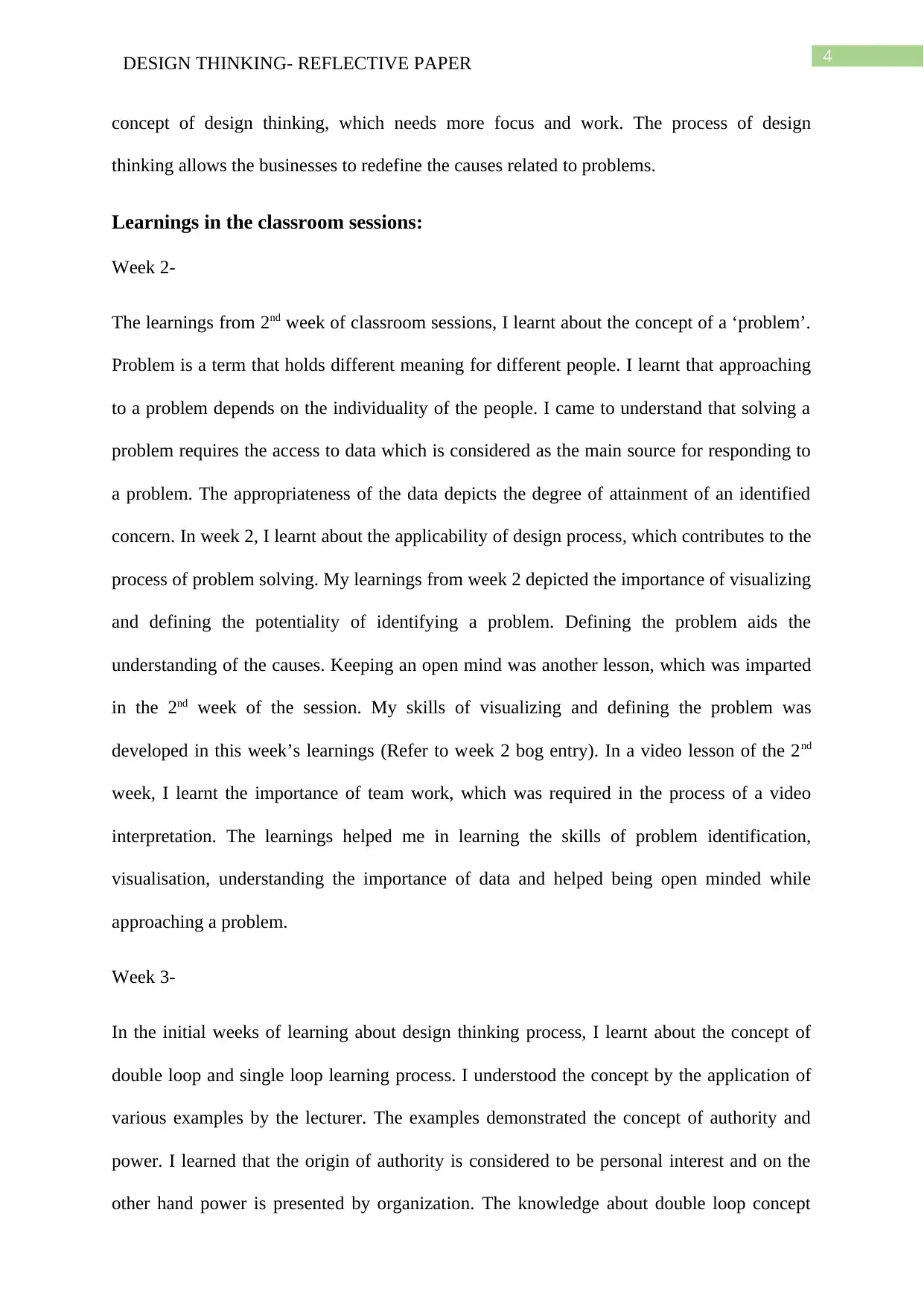
4DESIGN THINKING- REFLECTIVE PAPER
concept of design thinking, which needs more focus and work. The process of design
thinking allows the businesses to redefine the causes related to problems.
Learnings in the classroom sessions:
Week 2-
The learnings from 2nd week of classroom sessions, I learnt about the concept of a ‘problem’.
Problem is a term that holds different meaning for different people. I learnt that approaching
to a problem depends on the individuality of the people. I came to understand that solving a
problem requires the access to data which is considered as the main source for responding to
a problem. The appropriateness of the data depicts the degree of attainment of an identified
concern. In week 2, I learnt about the applicability of design process, which contributes to the
process of problem solving. My learnings from week 2 depicted the importance of visualizing
and defining the potentiality of identifying a problem. Defining the problem aids the
understanding of the causes. Keeping an open mind was another lesson, which was imparted
in the 2nd week of the session. My skills of visualizing and defining the problem was
developed in this week’s learnings (Refer to week 2 bog entry). In a video lesson of the 2nd
week, I learnt the importance of team work, which was required in the process of a video
interpretation. The learnings helped me in learning the skills of problem identification,
visualisation, understanding the importance of data and helped being open minded while
approaching a problem.
Week 3-
In the initial weeks of learning about design thinking process, I learnt about the concept of
double loop and single loop learning process. I understood the concept by the application of
various examples by the lecturer. The examples demonstrated the concept of authority and
power. I learned that the origin of authority is considered to be personal interest and on the
other hand power is presented by organization. The knowledge about double loop concept
concept of design thinking, which needs more focus and work. The process of design
thinking allows the businesses to redefine the causes related to problems.
Learnings in the classroom sessions:
Week 2-
The learnings from 2nd week of classroom sessions, I learnt about the concept of a ‘problem’.
Problem is a term that holds different meaning for different people. I learnt that approaching
to a problem depends on the individuality of the people. I came to understand that solving a
problem requires the access to data which is considered as the main source for responding to
a problem. The appropriateness of the data depicts the degree of attainment of an identified
concern. In week 2, I learnt about the applicability of design process, which contributes to the
process of problem solving. My learnings from week 2 depicted the importance of visualizing
and defining the potentiality of identifying a problem. Defining the problem aids the
understanding of the causes. Keeping an open mind was another lesson, which was imparted
in the 2nd week of the session. My skills of visualizing and defining the problem was
developed in this week’s learnings (Refer to week 2 bog entry). In a video lesson of the 2nd
week, I learnt the importance of team work, which was required in the process of a video
interpretation. The learnings helped me in learning the skills of problem identification,
visualisation, understanding the importance of data and helped being open minded while
approaching a problem.
Week 3-
In the initial weeks of learning about design thinking process, I learnt about the concept of
double loop and single loop learning process. I understood the concept by the application of
various examples by the lecturer. The examples demonstrated the concept of authority and
power. I learned that the origin of authority is considered to be personal interest and on the
other hand power is presented by organization. The knowledge about double loop concept
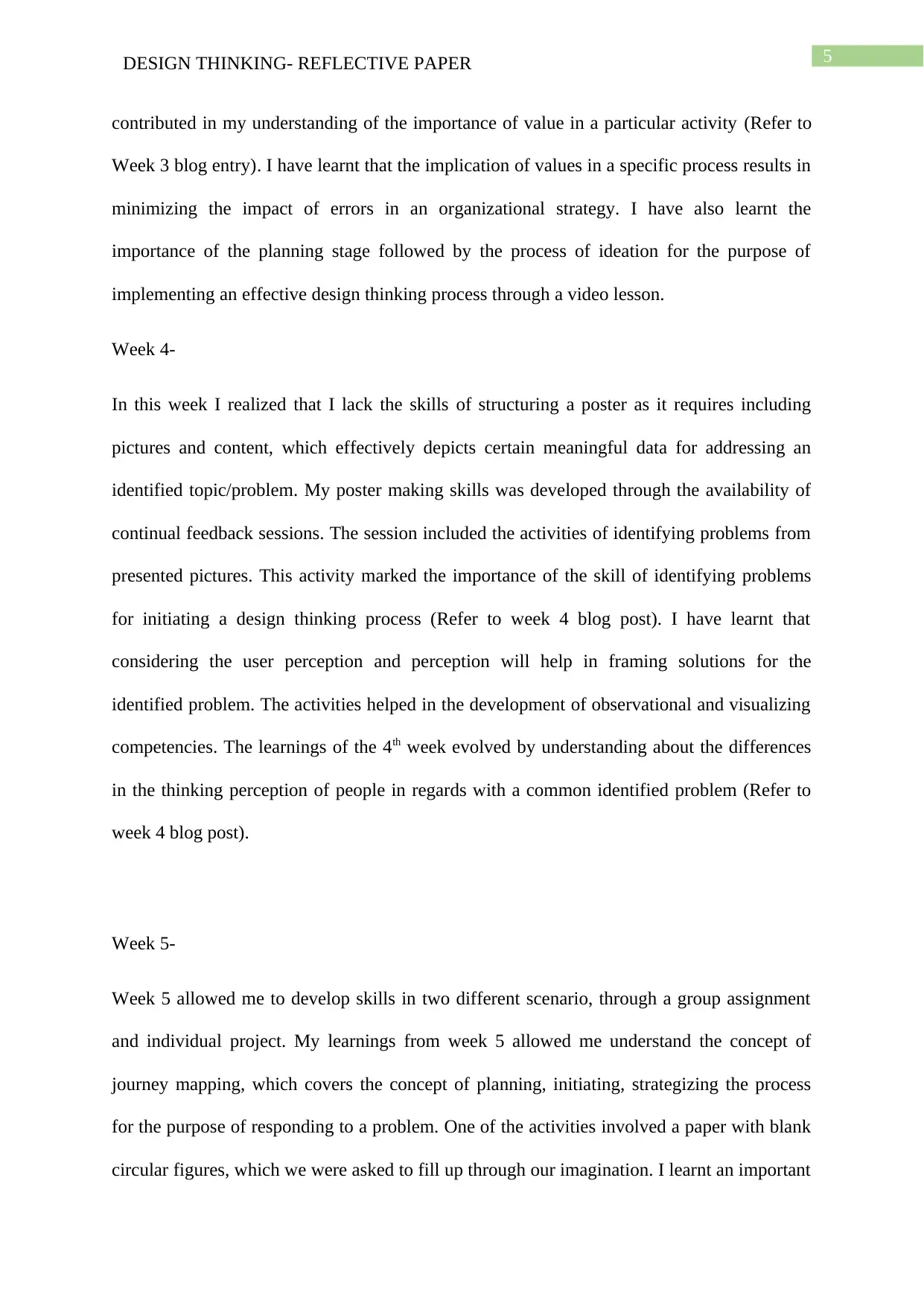
5DESIGN THINKING- REFLECTIVE PAPER
contributed in my understanding of the importance of value in a particular activity (Refer to
Week 3 blog entry). I have learnt that the implication of values in a specific process results in
minimizing the impact of errors in an organizational strategy. I have also learnt the
importance of the planning stage followed by the process of ideation for the purpose of
implementing an effective design thinking process through a video lesson.
Week 4-
In this week I realized that I lack the skills of structuring a poster as it requires including
pictures and content, which effectively depicts certain meaningful data for addressing an
identified topic/problem. My poster making skills was developed through the availability of
continual feedback sessions. The session included the activities of identifying problems from
presented pictures. This activity marked the importance of the skill of identifying problems
for initiating a design thinking process (Refer to week 4 blog post). I have learnt that
considering the user perception and perception will help in framing solutions for the
identified problem. The activities helped in the development of observational and visualizing
competencies. The learnings of the 4th week evolved by understanding about the differences
in the thinking perception of people in regards with a common identified problem (Refer to
week 4 blog post).
Week 5-
Week 5 allowed me to develop skills in two different scenario, through a group assignment
and individual project. My learnings from week 5 allowed me understand the concept of
journey mapping, which covers the concept of planning, initiating, strategizing the process
for the purpose of responding to a problem. One of the activities involved a paper with blank
circular figures, which we were asked to fill up through our imagination. I learnt an important
contributed in my understanding of the importance of value in a particular activity (Refer to
Week 3 blog entry). I have learnt that the implication of values in a specific process results in
minimizing the impact of errors in an organizational strategy. I have also learnt the
importance of the planning stage followed by the process of ideation for the purpose of
implementing an effective design thinking process through a video lesson.
Week 4-
In this week I realized that I lack the skills of structuring a poster as it requires including
pictures and content, which effectively depicts certain meaningful data for addressing an
identified topic/problem. My poster making skills was developed through the availability of
continual feedback sessions. The session included the activities of identifying problems from
presented pictures. This activity marked the importance of the skill of identifying problems
for initiating a design thinking process (Refer to week 4 blog post). I have learnt that
considering the user perception and perception will help in framing solutions for the
identified problem. The activities helped in the development of observational and visualizing
competencies. The learnings of the 4th week evolved by understanding about the differences
in the thinking perception of people in regards with a common identified problem (Refer to
week 4 blog post).
Week 5-
Week 5 allowed me to develop skills in two different scenario, through a group assignment
and individual project. My learnings from week 5 allowed me understand the concept of
journey mapping, which covers the concept of planning, initiating, strategizing the process
for the purpose of responding to a problem. One of the activities involved a paper with blank
circular figures, which we were asked to fill up through our imagination. I learnt an important
⊘ This is a preview!⊘
Do you want full access?
Subscribe today to unlock all pages.

Trusted by 1+ million students worldwide
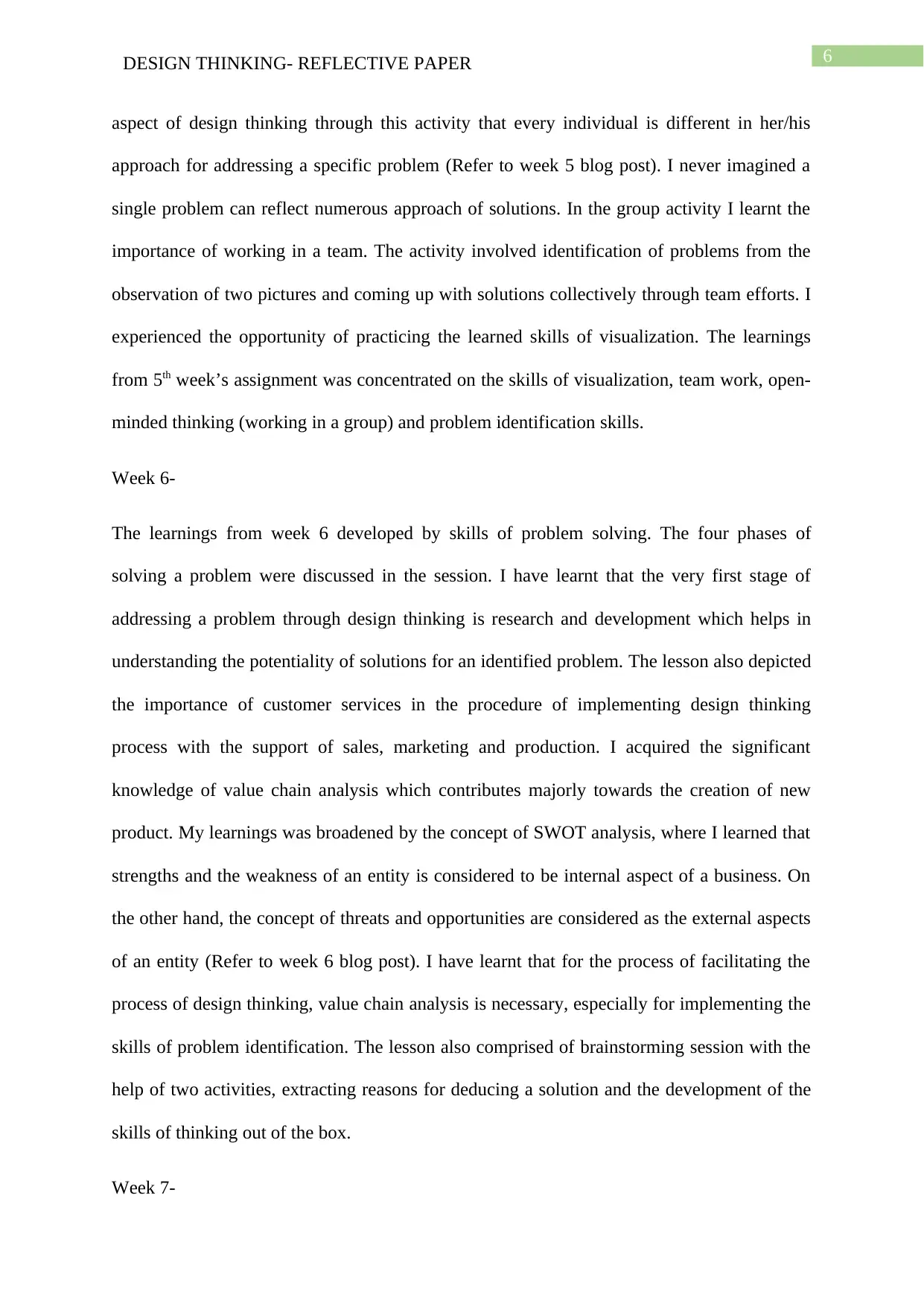
6DESIGN THINKING- REFLECTIVE PAPER
aspect of design thinking through this activity that every individual is different in her/his
approach for addressing a specific problem (Refer to week 5 blog post). I never imagined a
single problem can reflect numerous approach of solutions. In the group activity I learnt the
importance of working in a team. The activity involved identification of problems from the
observation of two pictures and coming up with solutions collectively through team efforts. I
experienced the opportunity of practicing the learned skills of visualization. The learnings
from 5th week’s assignment was concentrated on the skills of visualization, team work, open-
minded thinking (working in a group) and problem identification skills.
Week 6-
The learnings from week 6 developed by skills of problem solving. The four phases of
solving a problem were discussed in the session. I have learnt that the very first stage of
addressing a problem through design thinking is research and development which helps in
understanding the potentiality of solutions for an identified problem. The lesson also depicted
the importance of customer services in the procedure of implementing design thinking
process with the support of sales, marketing and production. I acquired the significant
knowledge of value chain analysis which contributes majorly towards the creation of new
product. My learnings was broadened by the concept of SWOT analysis, where I learned that
strengths and the weakness of an entity is considered to be internal aspect of a business. On
the other hand, the concept of threats and opportunities are considered as the external aspects
of an entity (Refer to week 6 blog post). I have learnt that for the process of facilitating the
process of design thinking, value chain analysis is necessary, especially for implementing the
skills of problem identification. The lesson also comprised of brainstorming session with the
help of two activities, extracting reasons for deducing a solution and the development of the
skills of thinking out of the box.
Week 7-
aspect of design thinking through this activity that every individual is different in her/his
approach for addressing a specific problem (Refer to week 5 blog post). I never imagined a
single problem can reflect numerous approach of solutions. In the group activity I learnt the
importance of working in a team. The activity involved identification of problems from the
observation of two pictures and coming up with solutions collectively through team efforts. I
experienced the opportunity of practicing the learned skills of visualization. The learnings
from 5th week’s assignment was concentrated on the skills of visualization, team work, open-
minded thinking (working in a group) and problem identification skills.
Week 6-
The learnings from week 6 developed by skills of problem solving. The four phases of
solving a problem were discussed in the session. I have learnt that the very first stage of
addressing a problem through design thinking is research and development which helps in
understanding the potentiality of solutions for an identified problem. The lesson also depicted
the importance of customer services in the procedure of implementing design thinking
process with the support of sales, marketing and production. I acquired the significant
knowledge of value chain analysis which contributes majorly towards the creation of new
product. My learnings was broadened by the concept of SWOT analysis, where I learned that
strengths and the weakness of an entity is considered to be internal aspect of a business. On
the other hand, the concept of threats and opportunities are considered as the external aspects
of an entity (Refer to week 6 blog post). I have learnt that for the process of facilitating the
process of design thinking, value chain analysis is necessary, especially for implementing the
skills of problem identification. The lesson also comprised of brainstorming session with the
help of two activities, extracting reasons for deducing a solution and the development of the
skills of thinking out of the box.
Week 7-
Paraphrase This Document
Need a fresh take? Get an instant paraphrase of this document with our AI Paraphraser
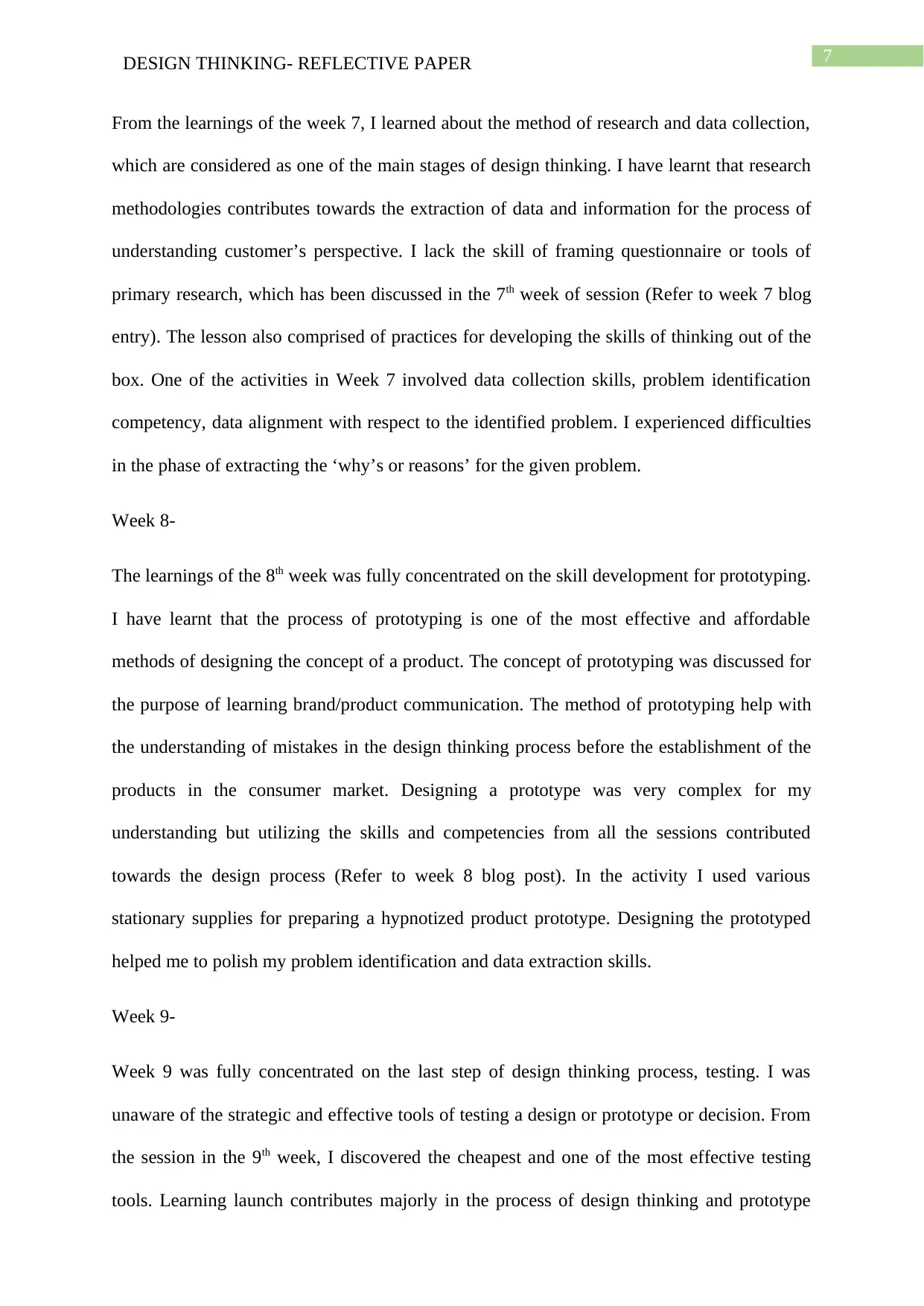
7DESIGN THINKING- REFLECTIVE PAPER
From the learnings of the week 7, I learned about the method of research and data collection,
which are considered as one of the main stages of design thinking. I have learnt that research
methodologies contributes towards the extraction of data and information for the process of
understanding customer’s perspective. I lack the skill of framing questionnaire or tools of
primary research, which has been discussed in the 7th week of session (Refer to week 7 blog
entry). The lesson also comprised of practices for developing the skills of thinking out of the
box. One of the activities in Week 7 involved data collection skills, problem identification
competency, data alignment with respect to the identified problem. I experienced difficulties
in the phase of extracting the ‘why’s or reasons’ for the given problem.
Week 8-
The learnings of the 8th week was fully concentrated on the skill development for prototyping.
I have learnt that the process of prototyping is one of the most effective and affordable
methods of designing the concept of a product. The concept of prototyping was discussed for
the purpose of learning brand/product communication. The method of prototyping help with
the understanding of mistakes in the design thinking process before the establishment of the
products in the consumer market. Designing a prototype was very complex for my
understanding but utilizing the skills and competencies from all the sessions contributed
towards the design process (Refer to week 8 blog post). In the activity I used various
stationary supplies for preparing a hypnotized product prototype. Designing the prototyped
helped me to polish my problem identification and data extraction skills.
Week 9-
Week 9 was fully concentrated on the last step of design thinking process, testing. I was
unaware of the strategic and effective tools of testing a design or prototype or decision. From
the session in the 9th week, I discovered the cheapest and one of the most effective testing
tools. Learning launch contributes majorly in the process of design thinking and prototype
From the learnings of the week 7, I learned about the method of research and data collection,
which are considered as one of the main stages of design thinking. I have learnt that research
methodologies contributes towards the extraction of data and information for the process of
understanding customer’s perspective. I lack the skill of framing questionnaire or tools of
primary research, which has been discussed in the 7th week of session (Refer to week 7 blog
entry). The lesson also comprised of practices for developing the skills of thinking out of the
box. One of the activities in Week 7 involved data collection skills, problem identification
competency, data alignment with respect to the identified problem. I experienced difficulties
in the phase of extracting the ‘why’s or reasons’ for the given problem.
Week 8-
The learnings of the 8th week was fully concentrated on the skill development for prototyping.
I have learnt that the process of prototyping is one of the most effective and affordable
methods of designing the concept of a product. The concept of prototyping was discussed for
the purpose of learning brand/product communication. The method of prototyping help with
the understanding of mistakes in the design thinking process before the establishment of the
products in the consumer market. Designing a prototype was very complex for my
understanding but utilizing the skills and competencies from all the sessions contributed
towards the design process (Refer to week 8 blog post). In the activity I used various
stationary supplies for preparing a hypnotized product prototype. Designing the prototyped
helped me to polish my problem identification and data extraction skills.
Week 9-
Week 9 was fully concentrated on the last step of design thinking process, testing. I was
unaware of the strategic and effective tools of testing a design or prototype or decision. From
the session in the 9th week, I discovered the cheapest and one of the most effective testing
tools. Learning launch contributes majorly in the process of design thinking and prototype
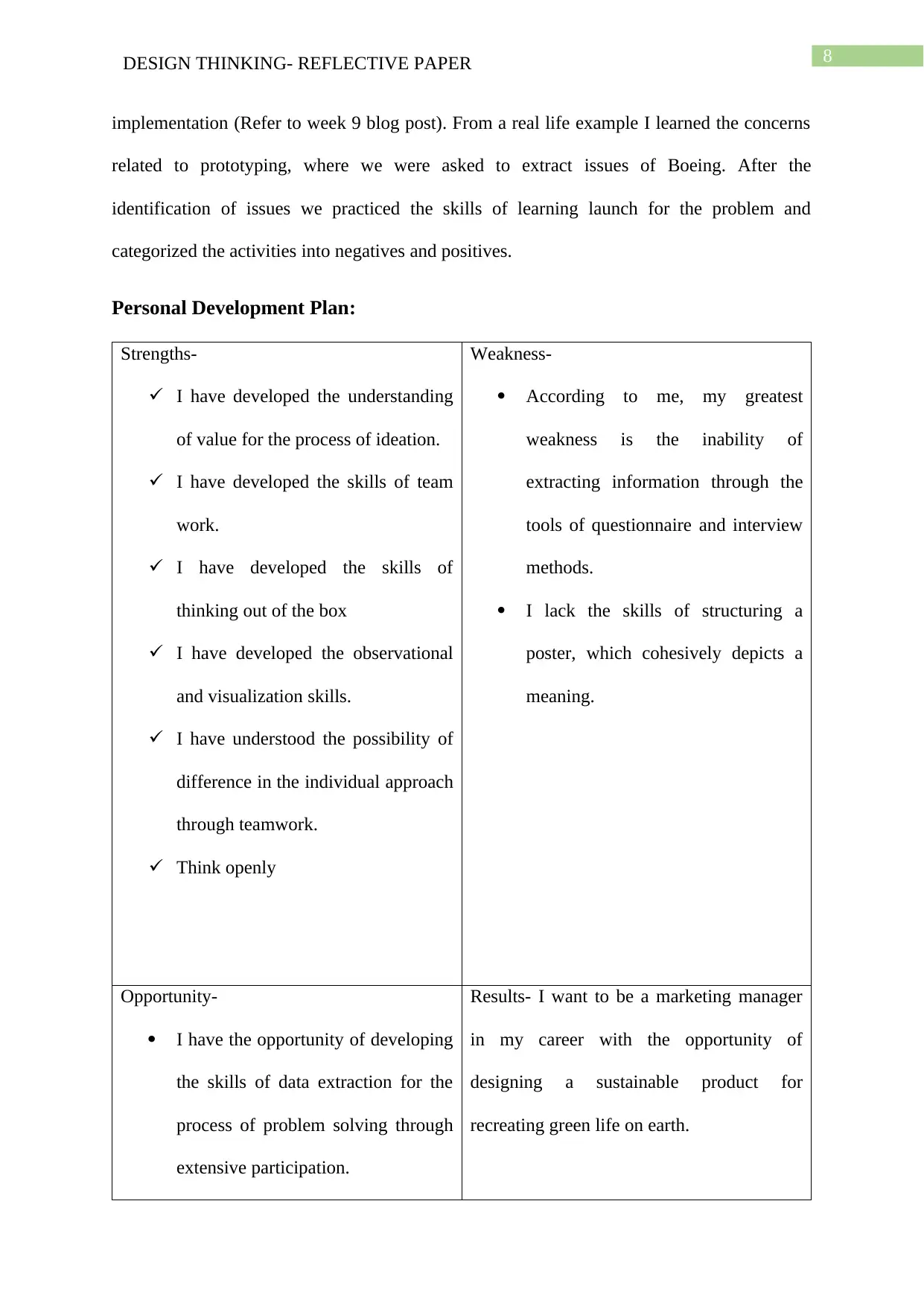
8DESIGN THINKING- REFLECTIVE PAPER
implementation (Refer to week 9 blog post). From a real life example I learned the concerns
related to prototyping, where we were asked to extract issues of Boeing. After the
identification of issues we practiced the skills of learning launch for the problem and
categorized the activities into negatives and positives.
Personal Development Plan:
Strengths-
I have developed the understanding
of value for the process of ideation.
I have developed the skills of team
work.
I have developed the skills of
thinking out of the box
I have developed the observational
and visualization skills.
I have understood the possibility of
difference in the individual approach
through teamwork.
Think openly
Weakness-
According to me, my greatest
weakness is the inability of
extracting information through the
tools of questionnaire and interview
methods.
I lack the skills of structuring a
poster, which cohesively depicts a
meaning.
Opportunity-
I have the opportunity of developing
the skills of data extraction for the
process of problem solving through
extensive participation.
Results- I want to be a marketing manager
in my career with the opportunity of
designing a sustainable product for
recreating green life on earth.
implementation (Refer to week 9 blog post). From a real life example I learned the concerns
related to prototyping, where we were asked to extract issues of Boeing. After the
identification of issues we practiced the skills of learning launch for the problem and
categorized the activities into negatives and positives.
Personal Development Plan:
Strengths-
I have developed the understanding
of value for the process of ideation.
I have developed the skills of team
work.
I have developed the skills of
thinking out of the box
I have developed the observational
and visualization skills.
I have understood the possibility of
difference in the individual approach
through teamwork.
Think openly
Weakness-
According to me, my greatest
weakness is the inability of
extracting information through the
tools of questionnaire and interview
methods.
I lack the skills of structuring a
poster, which cohesively depicts a
meaning.
Opportunity-
I have the opportunity of developing
the skills of data extraction for the
process of problem solving through
extensive participation.
Results- I want to be a marketing manager
in my career with the opportunity of
designing a sustainable product for
recreating green life on earth.
⊘ This is a preview!⊘
Do you want full access?
Subscribe today to unlock all pages.

Trusted by 1+ million students worldwide
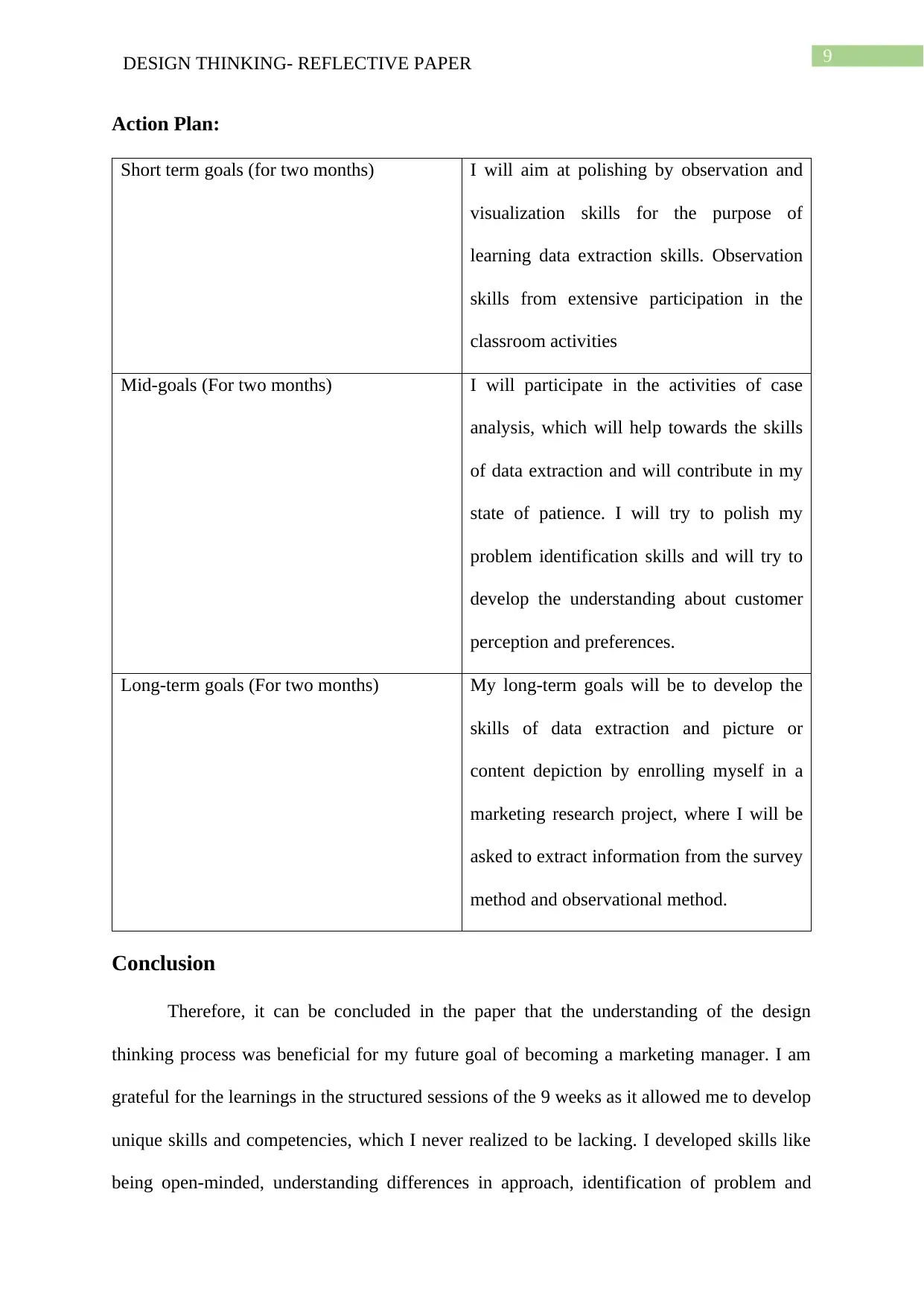
9DESIGN THINKING- REFLECTIVE PAPER
Action Plan:
Short term goals (for two months) I will aim at polishing by observation and
visualization skills for the purpose of
learning data extraction skills. Observation
skills from extensive participation in the
classroom activities
Mid-goals (For two months) I will participate in the activities of case
analysis, which will help towards the skills
of data extraction and will contribute in my
state of patience. I will try to polish my
problem identification skills and will try to
develop the understanding about customer
perception and preferences.
Long-term goals (For two months) My long-term goals will be to develop the
skills of data extraction and picture or
content depiction by enrolling myself in a
marketing research project, where I will be
asked to extract information from the survey
method and observational method.
Conclusion
Therefore, it can be concluded in the paper that the understanding of the design
thinking process was beneficial for my future goal of becoming a marketing manager. I am
grateful for the learnings in the structured sessions of the 9 weeks as it allowed me to develop
unique skills and competencies, which I never realized to be lacking. I developed skills like
being open-minded, understanding differences in approach, identification of problem and
Action Plan:
Short term goals (for two months) I will aim at polishing by observation and
visualization skills for the purpose of
learning data extraction skills. Observation
skills from extensive participation in the
classroom activities
Mid-goals (For two months) I will participate in the activities of case
analysis, which will help towards the skills
of data extraction and will contribute in my
state of patience. I will try to polish my
problem identification skills and will try to
develop the understanding about customer
perception and preferences.
Long-term goals (For two months) My long-term goals will be to develop the
skills of data extraction and picture or
content depiction by enrolling myself in a
marketing research project, where I will be
asked to extract information from the survey
method and observational method.
Conclusion
Therefore, it can be concluded in the paper that the understanding of the design
thinking process was beneficial for my future goal of becoming a marketing manager. I am
grateful for the learnings in the structured sessions of the 9 weeks as it allowed me to develop
unique skills and competencies, which I never realized to be lacking. I developed skills like
being open-minded, understanding differences in approach, identification of problem and
Paraphrase This Document
Need a fresh take? Get an instant paraphrase of this document with our AI Paraphraser
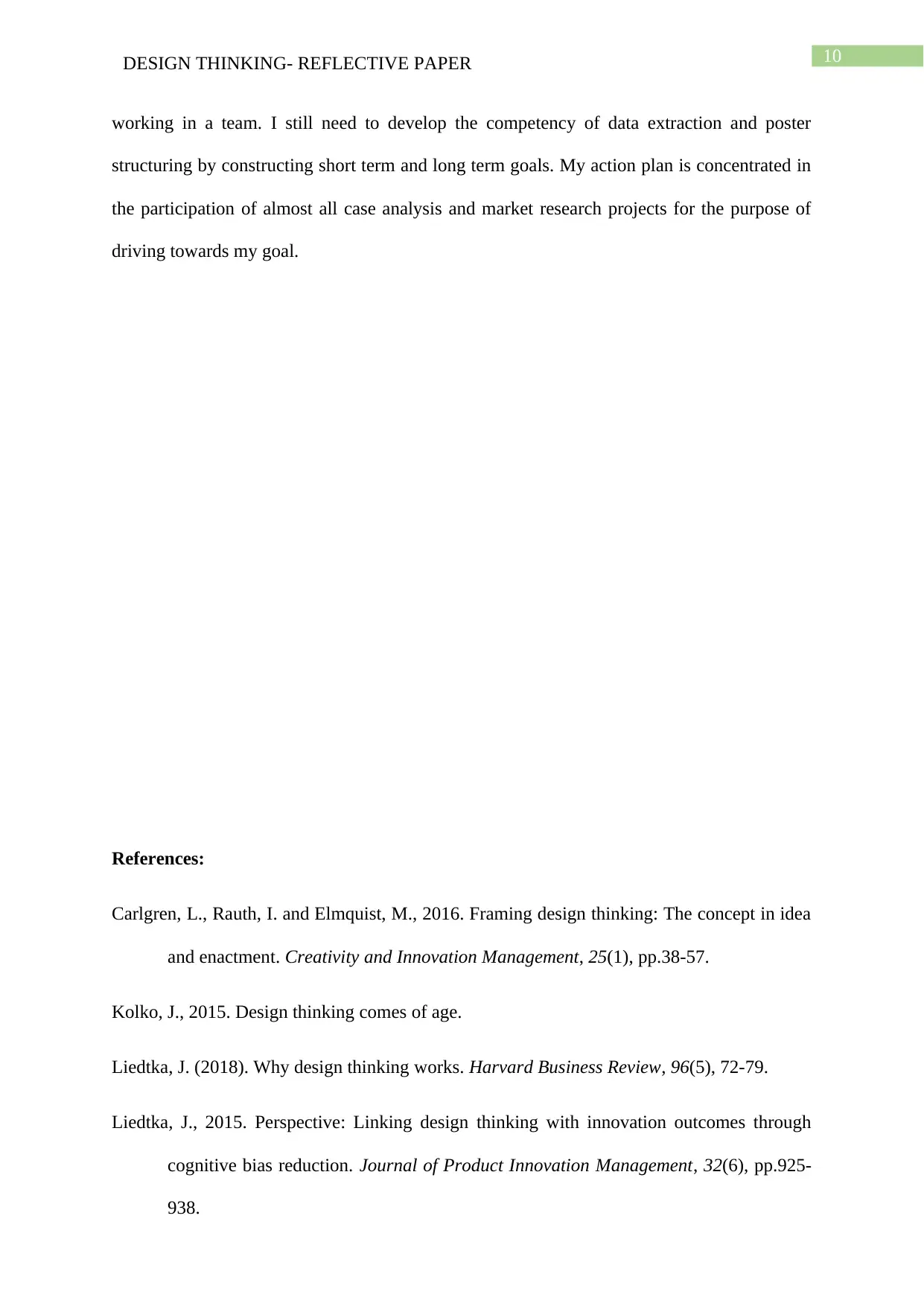
10DESIGN THINKING- REFLECTIVE PAPER
working in a team. I still need to develop the competency of data extraction and poster
structuring by constructing short term and long term goals. My action plan is concentrated in
the participation of almost all case analysis and market research projects for the purpose of
driving towards my goal.
References:
Carlgren, L., Rauth, I. and Elmquist, M., 2016. Framing design thinking: The concept in idea
and enactment. Creativity and Innovation Management, 25(1), pp.38-57.
Kolko, J., 2015. Design thinking comes of age.
Liedtka, J. (2018). Why design thinking works. Harvard Business Review, 96(5), 72-79.
Liedtka, J., 2015. Perspective: Linking design thinking with innovation outcomes through
cognitive bias reduction. Journal of Product Innovation Management, 32(6), pp.925-
938.
working in a team. I still need to develop the competency of data extraction and poster
structuring by constructing short term and long term goals. My action plan is concentrated in
the participation of almost all case analysis and market research projects for the purpose of
driving towards my goal.
References:
Carlgren, L., Rauth, I. and Elmquist, M., 2016. Framing design thinking: The concept in idea
and enactment. Creativity and Innovation Management, 25(1), pp.38-57.
Kolko, J., 2015. Design thinking comes of age.
Liedtka, J. (2018). Why design thinking works. Harvard Business Review, 96(5), 72-79.
Liedtka, J., 2015. Perspective: Linking design thinking with innovation outcomes through
cognitive bias reduction. Journal of Product Innovation Management, 32(6), pp.925-
938.
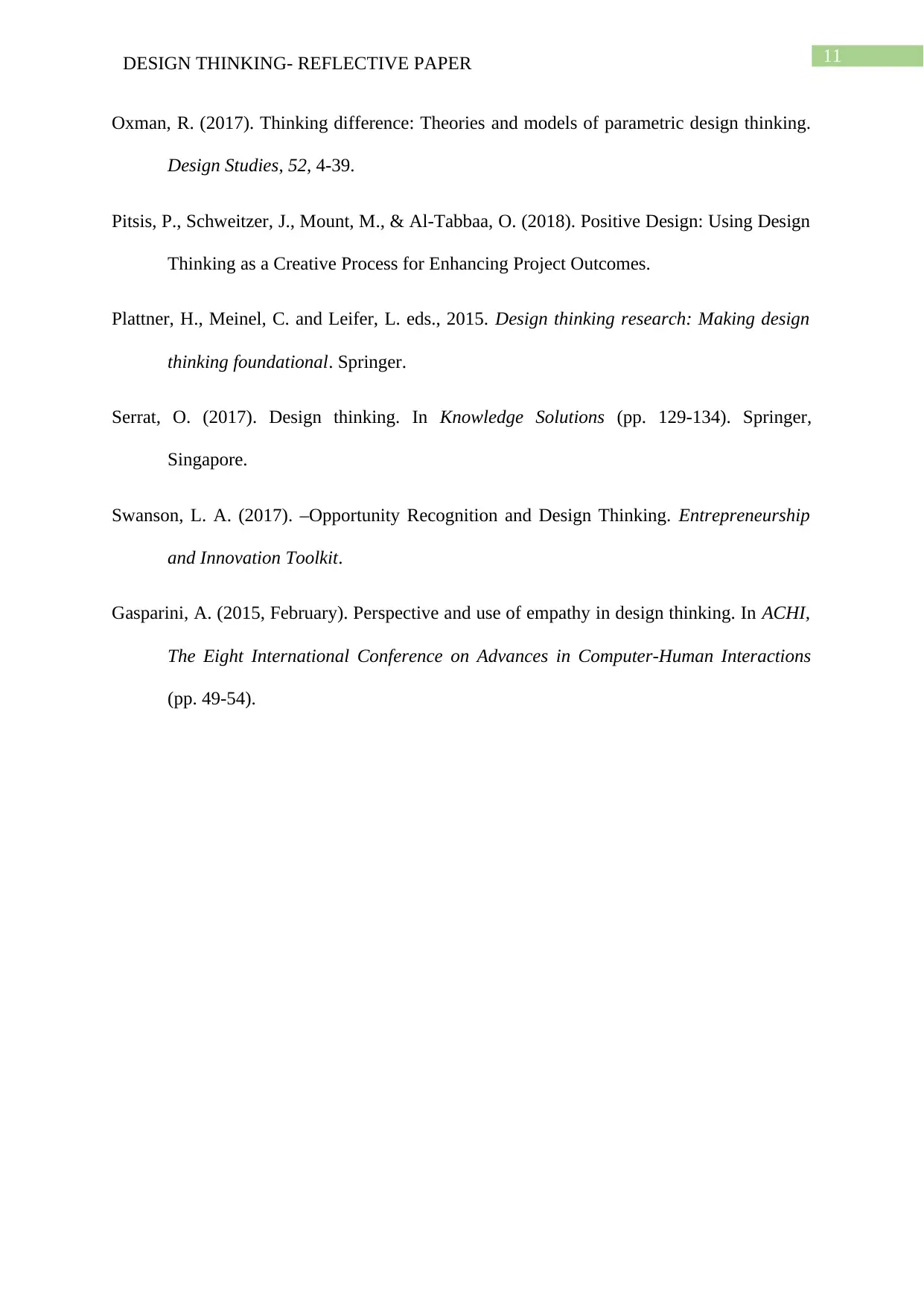
11DESIGN THINKING- REFLECTIVE PAPER
Oxman, R. (2017). Thinking difference: Theories and models of parametric design thinking.
Design Studies, 52, 4-39.
Pitsis, P., Schweitzer, J., Mount, M., & Al-Tabbaa, O. (2018). Positive Design: Using Design
Thinking as a Creative Process for Enhancing Project Outcomes.
Plattner, H., Meinel, C. and Leifer, L. eds., 2015. Design thinking research: Making design
thinking foundational. Springer.
Serrat, O. (2017). Design thinking. In Knowledge Solutions (pp. 129-134). Springer,
Singapore.
Swanson, L. A. (2017). –Opportunity Recognition and Design Thinking. Entrepreneurship
and Innovation Toolkit.
Gasparini, A. (2015, February). Perspective and use of empathy in design thinking. In ACHI,
The Eight International Conference on Advances in Computer-Human Interactions
(pp. 49-54).
Oxman, R. (2017). Thinking difference: Theories and models of parametric design thinking.
Design Studies, 52, 4-39.
Pitsis, P., Schweitzer, J., Mount, M., & Al-Tabbaa, O. (2018). Positive Design: Using Design
Thinking as a Creative Process for Enhancing Project Outcomes.
Plattner, H., Meinel, C. and Leifer, L. eds., 2015. Design thinking research: Making design
thinking foundational. Springer.
Serrat, O. (2017). Design thinking. In Knowledge Solutions (pp. 129-134). Springer,
Singapore.
Swanson, L. A. (2017). –Opportunity Recognition and Design Thinking. Entrepreneurship
and Innovation Toolkit.
Gasparini, A. (2015, February). Perspective and use of empathy in design thinking. In ACHI,
The Eight International Conference on Advances in Computer-Human Interactions
(pp. 49-54).
⊘ This is a preview!⊘
Do you want full access?
Subscribe today to unlock all pages.

Trusted by 1+ million students worldwide
1 out of 12
Related Documents
Your All-in-One AI-Powered Toolkit for Academic Success.
+13062052269
info@desklib.com
Available 24*7 on WhatsApp / Email
![[object Object]](/_next/static/media/star-bottom.7253800d.svg)
Unlock your academic potential
Copyright © 2020–2025 A2Z Services. All Rights Reserved. Developed and managed by ZUCOL.




